Nine months ago, I analyzed a report that would transform not only my role on the HubSpot blogging team, but also the whole blog's editorial strategy. The results have been nothing short of eye-opening. And I'm not just talking about the findings from the report -- I'm also talking about the business results we've generated from the shift we made in our blogging strategy because of those findings.

That shift is an ongoing internal project we call "historical optimization." The goal? Update old blog content and generate more traffic and leads from it in the process.
Great for us, right? Hang on -- it's great for you, too. I'm writing about all this because any experienced blogger who's tasked with growing and scaling the results they generate from their blog needs to know about it. The thing is, no one is really talking about it ... yet.
As a result of HubSpot's ongoing historical optimization, we've been able to generate way more value from content we've published in the past. As a matter of fact ...
- We've more than doubled the number of monthly leads generated by the old posts we've optimized.
- We've increased the number of monthly organic search views of old posts we've optimized by an average of 106%.
So I'm going to tell you the story of the historical optimization project, explain what we've done to achieve those results, and touch on how you can do it, too.
Want an overview of all of 2021's must-have blogging tips? Check out this quick video before moving on to dig deeper into historical optimization:
What Is Historical Optimization?
Simply put, historical optimization means optimizing your "old" blog content so it's fresh, up-to-date, and has the ability to generate even more traffic and conversions than it already does. By "old," I just mean posts that already exist on your blog -- whether you wrote them last month or three years ago.
If you're not sure whether it really has a place in your blogging strategy, let me tell you the story about how our focus on historical optimization came to be and why we realized it was so important.
I had just returned to work from my three-month maternity leave, and I learned that the product team had just released a new tool within the HubSpot Marketing Platform called Attribution Reports.
Attribution Reports enabled us to better determine how many new leads each of our individual blog posts directly generated. And since I'm responsible for the optimization and growth of HubSpot's core blogs, I started analyzing our Attribution Reports as soon as I could, hoping to discover some actionable nuggets of wisdom my team could use in one way or another.
Discoveries From the Attribution Report Analysis
My Attribution Report analysis was an attempt to determine which of our blog posts were the most influential in generating leads -- which posts got the most visitors to click on a call-to-action within the post and convert on the landing page it directed them to. In other words, use last touch attribution to figure out exactly which posts directly resulted in lead generation.
When I came out from the other side of that analysis, this is what I'd discovered:
- 76% of our monthly blog views came from "old" posts (in other words, posts published prior to that month).
- 92% of our monthly blog leads also came from "old" posts.

So essentially, if the whole blogging team went on vacation for a month, we'd still generate 76% of the traffic and 92% of the leads we would've otherwise generated by also publishing new content. That may sound like an oversimplification, but still ... nuts, right?
Here's another crazy tidbit I learned:
- 46% of our monthly blog leads came from just 30 individual blog posts.
I'll let that sink in a little.
Now what if I also told you we publish about 200 new posts every month, and at that time, we had accumulated nearly 6,000 total posts on our blog?
Here's some perspective. The pie chart on the left shows the distribution of monthly leads we were generating, and the pie chart on the right shows the distribution of posts we had on our blog.
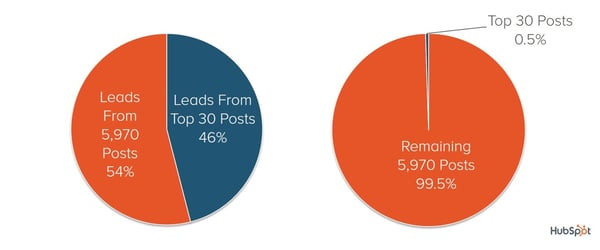
This seems pretty crazy, right?
Our Light Bulb Moment: Optimizing the Past
What's funny is, this shouldn't have been as surprising as it was. In fact, it's exactly what you'd expect to happen as an inbound marketer. Getting recurring, lasting value from old content is one of the main benefits of blogging. And the traffic sources for our top lead-generating posts supported it -- these were all posts that were generating a lot of traffic from organic search month after month after month.
Once the sticker shock of all these findings wore off, we had to decide what to do with this newfound data and information. While we knew we couldn't just stop creating new content (after all, "new" eventually becomes "old"), it was clear we needed to make a change in our blogging strategy.
We came to two conclusions that have become the core components of the historical optimization project:
1) Figure out how to get more leads from our high-traffic but low-converting blog posts (AKA Historical Blog Conversion Optimization).
Being able to identify which posts were our top lead generators meant we could also identify which posts were our worst lead generators. Coupled with traffic data, we were able to determine which posts were generating a lot of traffic but had low conversion rates -- and potentially generate a lot more leads from content we already have by improving those conversion rates.
2) Figure out how to get more traffic to our high-converting posts (AKA Historical Blog Search Engine Optimization).
On the flip side, we also knew there were posts that converted well but weren't getting a lot of traffic month after month. If we could search engine optimize those high-converting posts, we could potentially get them to rank better and generate more traffic that we already know would convert well.
In other words, we should stop focusing only on brand new content, and try to get more traffic and leads out of the content we already have -- we should optimize the past.
And with that, the historical optimization project was born.
Why Historical Optimization Is More Important Now Than Ever Before
These days, we have a content overload problem. Just take a look at the graph below, which shows the number of new blog posts published on the WordPress blogging platform each month since October 2006. 58 million in May! And that's just on WordPress -- it doesn't even take into consideration the posts published on other blogging platforms like HubSpot's.
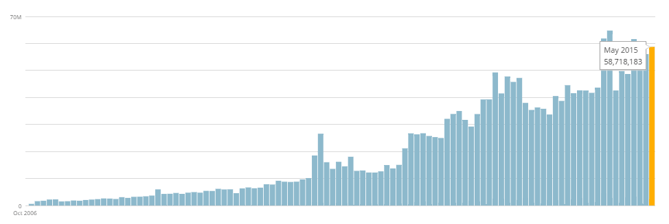
As more and more businesses have started buying into the importance of content marketing, more and more businesses are creating content. And as the supply increases, so does the competition for getting that content found online.
According to Paul Hewerdine of B2B marketing agency Earnest (via Forrester's 2014 report on building the case for content marketing), the problem is that "the supply of content is growing, but demand is static." In other words, the people on the receiving end of all this content are only going to consume so much. Their demand isn't growing with the supply.
The result, according to that same Forrester report, is that an estimated 50% of content from enterprises is going completely unused. So for marketers who have been blogging consistently for a while and are being tasked with growing and scaling their blogs, the answer can't just be to increase content production proportionally to the growth goals they need to achieve.
This is why historical optimization becomes so important. Not only is it a way to get more out of the content you already have; but it's also a way to get a leg up on such a competitive content landscape. And last, but certainly not least, it's a way to deliver even more value to the people reading your content. After all, if people are going to continue finding your older content through search engines, don’t you want it to be fresh and up-to-date?
Okay ... so how did we achieve those results I mentioned at the top of this article?
Historical Blog Conversion Optimization
We tackled the conversion optimization piece of the project first (figuring out how to get more leads from our high-traffic posts by improving their view-to-lead conversion rates). While we'd done some conversion optimization of old content in the past, without the Attribution Report, we had no way of knowing whether the changes we were making directly improved their conversion rates. Now we did!
The Playbook: Keyword-Based Conversion Rate Optimization
The very first thing we tried was conversion rate optimization based on offer relevancy -- in other words, pairing the most relevant offer we had with the subject matter of the post. This is exactly how we approach call-to-action (CTA) selection for brand new posts, but the idea was that as we've expanded our library of marketing offers over the years, we may now have a more relevant and/or better performing offer than we did when we first published the blog post.
The results of this approach were hit or miss: Sometimes we'd improve the conversion rate, sometimes it'd stay about the same, and in some cases, the conversion rate would actually decrease. The reason was that this approach was purely a guessing game -- it was based on assumptions about what the blog post's visitors were looking for.
What we needed was an approach based on data, not assumptions. So then we thought, what if we focus on the specific keywords people were using to find these posts? Knowing that the primary referral source of traffic to these posts was search engines like Google, we figured we could much more accurately understand and satisfy the needs of our blog visitors by matching the offer we promoted in the post with the keywords people were using to find it.
In other words, get inside searchers' heads and give the people what they really want.
So we tried it on one of our highest-traffic posts, which ranked highly for the keywords "how to write a press release" and "press release template."
Jackpot.

Using this keyword-based conversion optimization methodology, we increased the conversion rate of the post by 240%. In other words, this post generates 3X more leads now than it did before we conversion optimized it. Then we tried it on 12 more of our top-trafficked posts, and we doubled the number of leads we generated from them.
In fact, of the 75 posts we've conversion optimized using this method, we've increased the conversion rate on every single one.
So how did we do it?
How to Conversion Optimize Old Blog Posts Based on Keywords
I'm going to provide a brief explanation of how to execute keyword-based conversion optimization, but if you're looking for a more in-depth explanation, download our free ebook about historical optimization here. It explains each of the steps outlined below in much greater detail, and also provides a visual example of exactly what we do to posts we conversion optimize in this way.
- Step 1: Export your blog analytics to identify your top-viewed "old" blog posts.
- Step 2: Identify which keywords each post is getting found for using a combination of keyword research and a keyword tracking tool like HubSpot's. Then prioritize your keyword list based on the one or two keywords the majority of each post's traffic seems to be coming from.
- Step 3: Conversion optimize your posts using the target keywords identified in Step 2, incorporating those exact keyword phrase(s) into your posts' calls-to-action (CTAs).
Historical Blog Search Engine Optimization
The next part of the historical optimization project we tackled was search engine optimization. If you remember, the goal of historical search engine optimization is to improve the search rankings for posts that already convert well but aren't getting a lot of traffic from search. More traffic to these high-converting posts could result in more leads.
Someone once said (honestly, no one can figure out who to give credit to), "The best place to hide a dead body is page two of Google." If you're not sure what I mean by that, take a look at the following chart from a 2014 study conducted by Advanced Web Ranking, which shows the clickthrough rates of specific organic search ranking positions in Google:
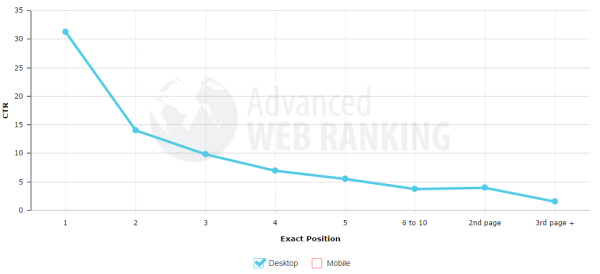
This chart shows that on average, results on page one of Google get 71% of the clicks. Results on pages two and three, on the other hand, only get about 6%. Furthermore, the first five positions on page one of Google get 68% of all clicks.
In other words, if you want to benefit from the lion's share of search traffic for a given keyword, you need to be on page one -- and you need to be near the top. So how do you get your blog posts to the top of page one?
The Playbook: Updating and Republishing Old Blog Posts
Since inbound links is still one of the most important ranking factors, our first thought was to use guest blogging as a way to generate more inbound links to the content we wanted to rank better. But considering how difficult that approach would be to scale, we decided to look more closely at the internal assets we had more control over instead.
Over the years, we'd dabbled in updating and republishing old content that had gotten stale and outdated. We targeted posts we knew still generated a lot of organic search traffic month after month, and the goal was primarily to keep this high-traffic content fresh and up-to-date for our search visitors.
Knowing that one of Google's ranking factors rewards freshness, I had a hunch one of the reasons these posts continued to do well was because we kept them updated. So I looked at our analytics to investigate. Sure enough, my hunch seemed to have some truth to it.
This graph shows how one particular blog post's rank has changed over time for the keyword "how to use linkedin." The date highlighted (3/26/2014) shows that this post ranked in the 19th position (i.e. the bottom of page 2) right before we updated it on 3/31/2014. If you look at the graph, it's pretty clear what happened after that.
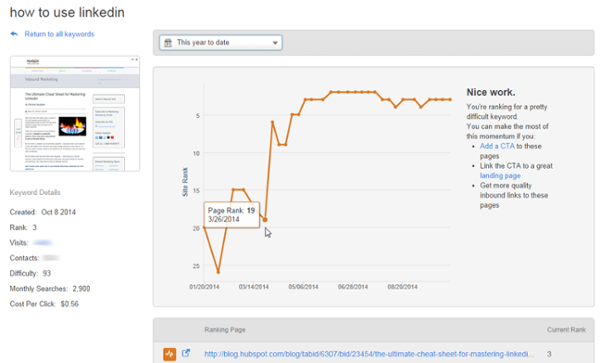
To me, this looked really promising. What if all we had to do to improve the keyword rankings of our blog posts was update and republish them as new? This would be a much more scalable solution for us for a number of reasons:
- We can update and republish posts a few posts per week.
- It supports more than one blogging team goal: historical optimization and new content creation.
- It replaces a new slot on our editorial calendar.
- It’s often less work than creating a brand new post from scratch.
Not only that -- it also makes for a better user experience for our organic search visitors. Instead of coming across content in search that is stale and outdated, they'd find fresh, up-to-date, and more valuable content. Now that's what I like to call a win-win.
So we decided to try it with a few posts.
Again, jackpot.
The chart below shows a sampling of six blog posts we've updated and republished. We used views generated from organic search as our primary KPI, because if the keyword ranking(s) for these posts improved as a result of the update, it would manifest as an increase in organic search views.
The "before" bars are a representation of the monthly views the posts generated from organic search before the updates, and the "after" bars represent the monthly views the posts generated from organic search after the updates. It's worth noting that we also waited a period of 30 days in between the "before" and "after" time frames to give Google some time to improve the ranking of the post based on the update.
In every instance, we improved the number of monthly views these posts generated from organic search. And using HubSpot, for each of these posts, we can also dig into the individual keywords they're ranking for and see how these rankings have improved as a result of the post update.
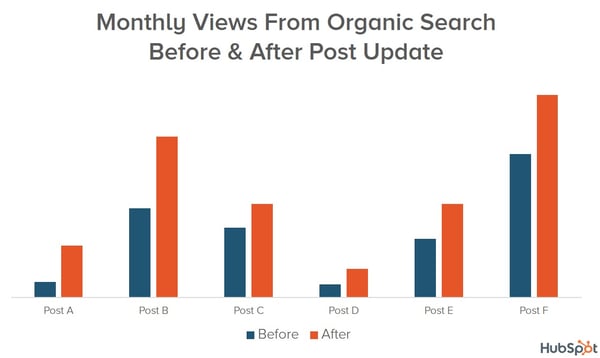
Based on this initial success, post updates are now a regular part of our blogging editorial strategy. We've incorporated about 2-3 post updates per week since we started scaling this project, and as we pointed out earlier, we've increased the number of monthly organic search views to posts we update and republish by an average of 106%.
And considering we also run the keyword-based conversion optimization playbook on all the posts we update and republish, we've also tripled the number of monthly leads we've generated from posts we've updated and republished.
Why Updating and Republishing Old Blog Content Leads to Better Search Rankings
If you're curious why this approach works so well, here are a few reasons:
- Google rewards freshness. So do searchers. As I mentioned earlier, in 2011 Google introduced a freshness factor into its ranking algorithm. It makes perfect sense -- high-quality, valuable content that's fresh and up-to-date is exactly what Google wants to surface to searchers. Simple enough, right? But I also want to share a little anecdote with you: When we were doing some usability testing of our most recent blog redesign, one of our testers mentioned that she consciously considers the publish date listed in search engine results pages (SERPs) for results she's considering clicking. She mentioned that she'll automatically disregard outdated results for fresher ones. Nod your head if you do the same thing. Case in point.
- You're building off the existing search authority the post has already accumulated. In other words, you're starting with a post that already has some degree of page authority, rather than starting completely from scratch.
- New visits naturally lead to new social shares and inbound links. By re-promoting your updated blog posts to your blog subscribers, social media followers, etc., you're generating a new surge of traffic from additional sources. This naturally leads to an increase in social shares and inbound links -- both important search ranking factors. This is also what makes it so important for you to have a substantial number of social media followers and blog subscribers -- the greater your reach, the more impactful your results will be.
Want to take advantage of this approach for yourself? Here's how to do it.
How to Update and Republish Old Blog Posts
While I'll briefly outline how to update and republish old blog content below, if you're looking for a more in-depth explanation, you should download our free ebook about historical optimization here.
- Step 1: Identify blog posts worth updating. Ideally, posts worth updating are outdated or can be improved in some way, and have the potential to rank higher for keywords whose search volume offers a promising opportunity. Our ebook can give you specifics how to do keyword research to determine what keywords a post has the potential to rank better for, as well as other criteria you should be considering when choosing posts to update.
- Step 2: Update the content of the post with the aim of achieving three goals -- accuracy, freshness, and comprehensiveness. In general, you should strive to make enough noticeable improvements to a post that warrant republishing it as new.
- Step 3: Conversion optimize and search engine optimize the post. Put all the keyword research you've done to work by conversion-optimizing the post using the keyword-based method mentioned earlier in this post as well as on-page search engine optimizing it using the keywords you identified in Step 1 above.
- Step 4: Publish your updated post as new by changing the publish date so it's featured as a brand new post on your blog. Then promote your updated content just like you would any brand new post. Email it to your blog subscribers, promote it in social media, and leverage any other promotional channels that work for promoting your content.
Who Should Do Historical Optimization?
Here's the thing: Historical optimization isn't a tactic meant for newer blogs that have only been around for a year or two. It's a tactic best-suited for a blog that's been around for several years, has already tried all the basic blog growth tactics, and is looking for brand new ways to grow. Here's why:
- You need to be generating a significant amount of organic search traffic. Because all of these approaches are mainly based on search traffic data, none of this really works unless you've been blogging long enough to be generating a significant amount of search traffic and have built up decent search authority.
- You need to have built up a critical mass of blog subscribers and social media followers. As I mentioned earlier, one of the reasons post updates perform so well for us is because of the surge of traffic generated by the promotion to our blog subscribers and social media followers. As a result, you'll only generate a significant return on investment if your subscriber and follower base is substantial. So if you're a newer blog, your first and foremost optimization focus should be to build those audiences and expand your reach.
- You need to have a sizable repository of old posts at your disposal. After all, historical optimization only makes sense if you have content worth optimizing.
Don't Sacrifice Creating New Blog Content for Updating Old Content
Before I wrap this up, one final word of caution ....
Historical optimization should be a piece of your overall blogging strategy -- not the whole strategy.
You can't completely give up on creating new blog posts in an attempt to optimize the past. Remember, the old content you're optimizing now was once brand new, and not every new post will turn into an SEO success story. So if you completely forgo new content marketing, you could be shooting your future self in the foot by giving yourself fewer chances to rank for new keywords. You could also miss out on capitalizing on new topics/trends emerging in your industry, as well as opportunities for thought leadership, among other benefits of new content.
That said, only you can decide what the right editorial balance is between updating old content and creating brand new content. As a starting point, audit your old content to determine how many post update opportunities you have. A blog that's been around for several years and has a large repository of content likely has more opportunities than a blog that's only been around for a couple of years.
Keep in mind that historical optimization is an ongoing project -- if it proves successful for you, it should become a permanent tactic in your blogging strategy like it's become for us. To help you track your historical optimization results, we've also included a free tracking template with the download of our historical optimization ebook. Get them both here.
If you're already adopting a historical optimization approach, share your experiences in the comments, and if you're new to historical optimization, give me a shout in the comments with any questions. Good luck optimizing the past!
![Download Now: How to Start a Successful Blog [Free Guide]](https://no-cache.hubspot.com/cta/default/53/79c9c1d7-e329-46a2-9095-7ebf693a17f9.png)










